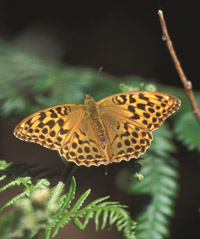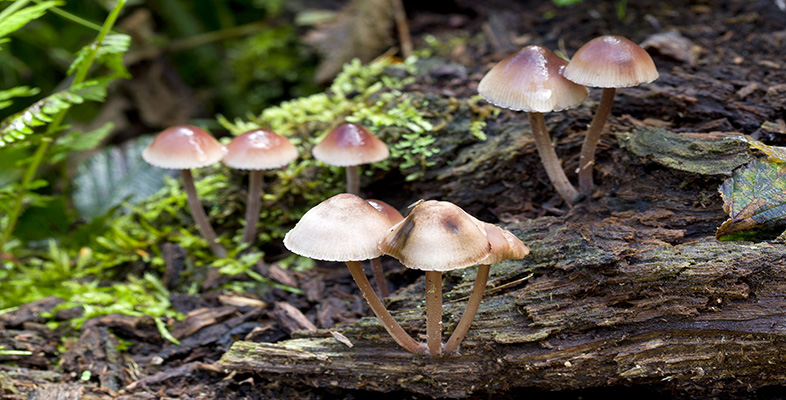1.2 Woodland species
Some woodland plants and animals are generalist species. They are found in woodland, but are also common in other habitats such as grassland, scrub, parks and gardens. Examples might include plants such as ivy or germander speedwell (Veronica chamaedrys), animals such as foxes or hedgehogs (Erinaceus europaeus), or birds like bluetits and chaffinches (Fringilla coelebs).
Others might use the wood as a convenient place for just part of the time. For instance, Leisler's bat (Nyctalus leisleri) hibernates in woodland trees in winter and the chiffchaff (Phylloscopus collybita) migrates to woodland for the summer.
At the opposite end of the spectrum are the true woodland specialist species. These species rely on trees and woods throughout their life cycle: birds such as the nuthatch (Sitta europaea) and all three species of woodpecker; mammals such as the red squirrel (Sciurus vulgaris); and specialist lichens and mosses such as the striated feather moss (Eurhynchium striatum).
You will recall from the clip that species found in woodland differ widely in their requirements, from the silver washed fritillary butterfly (Figure 2) that likes sunny patches in woodland glades to the black snake millipede (Tachypodoiulus sp.) that thrives on rotting wood and the birch polypore fungus that is found only on birch (Betula sp.).

The abundance of a particular species may also depend on how specialist it is. Once a common sight, the white letter hairstreak butterfly (Satyrium w-album) has declined dramatically with the loss of its only food plant – the elm (Ulmus sp.) – to Dutch elm disease.
The species perhaps most associated with woodland are squirrels. The native red squirrel is now only found in scattered populations in northern and western areas of the UK and on the Isle of Wight. It has suffered from loss of habitat, the deadly squirrel poxvirus and competition from the grey squirrel (Sciurus carolinensis), which was introduced from North America in the nineteenth century.
All of the UK's seventeen species of bat can be found in or around woodlands, but some are woodland specialists – such as the noctule (Nyctalus noctula), barbastelle (Barbastella barbastellus), Bechstein's (Myotis bechsteinii) and brown long-eared bat (Plecotus auritus). Brown long-eared bats prefer to forage in deciduous woodland (composed mainly of trees that lose their leaves in winter), where they glean insects from leaves and bark. Noctule bats are primarily tree dwellers and live mainly in rot holes and old woodpecker holes. Barbastelle bats roost in trees all year round, preferring ancient woodland with a substantial understorey.
Leaf litter is eaten and broken up by detritivores. These are invertebrates such as millipedes and woodlice. The decomposers (species of fungi and bacteria) continue the process and undertake chemical breakdown of the litter. Saproxylic species are those that obtain their nourishment solely from dead or decaying wood. By their actions, these groups of organisms release nutrients and make them available to be taken up by other plants.
Most fungi associated with woodland conform to one of the following alternative nutritional strategies:
- They are in a mutually beneficial (symbiotic) feeding relationship with tree roots, e.g. fly agaric fungus (Amanita muscaria) is associated with birch trees.
- They decompose wood or leaf litter, e.g. fairy bonnet (Coprinus disseminatus).
- More rarely, they may adopt a parasitic relationship, causing damage to the trees, e.g. honey fungus (Armillaria mellea).
It is the fruiting body of a fungus (the stage that produces the spores) that appears above ground, normally in warm and damp conditions (Figure 3).
